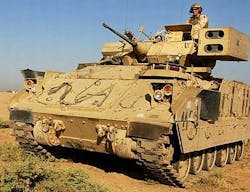BAE Systems chooses embedded computing from Curtiss-Wright for Bradley vetronics
SANTA CLARITA, Calif., 11 June 2013. Vetronics designers at the BAE Systems Land & Armaments segment in Santa Clara, Calif., needed rugged embedded computing for the latest version of the U.S. Army M2A3 Bradley Fighting Vehicle. They found their solution from Curtiss-Wright Controls Defense Solutions in Santa Clarita, Calif.
BAE Systems has awarded a contract to Curtiss-Wright to build the next generation vetronics central processing unit (CPU) on the Bradley Fighting Vehicle.
The initial contract is for $3 million, yet the estimated contract value over the lifetime of the program, which is expected to end in 2028, is $75 million, Curtiss-Wright officials say. Shipments start this month and continue through early 2015.
This contract results from the Engineering Change Proposal 2 (ECP 2) program for the Bradley, which BAE Systems was awarded in September, 2012.
Curtiss-Wright is providing the company's turret processor unit III (TPU III) subsystem, comprising its fire control processor III (FCP III) single board computer and COTS PMC-651 Ethernet switch. Additional general-purpose and graphics-processor cards will be analyzed to support the ECP 2 CPU upgrade program, company officials say.
The TPU III subsystem will provide computing power for the Bradley’s fire control system (FCS) as well as embedded training. The unit features a hybrid backplane for VME and VPX embedded computing.
Curtiss-Wright engineers developed the TPU III for the Bradley A2 ODS SA variant with a single-card TPU in the Bradley smart display. The FCP III is compatible with the Bradley FCS software.
The TPU III also provides options to enable hosting of the ABCT Common Embedded Training System (CETS) high definition (HD)-video based training to enable the Bradley crew to train inside the vehicle.
For more information contact Curtiss-Wright Controls Defense Solutions online at www.cwcdefense.com, or BAE Systems Land & Armaments at www.baesystems.com.

